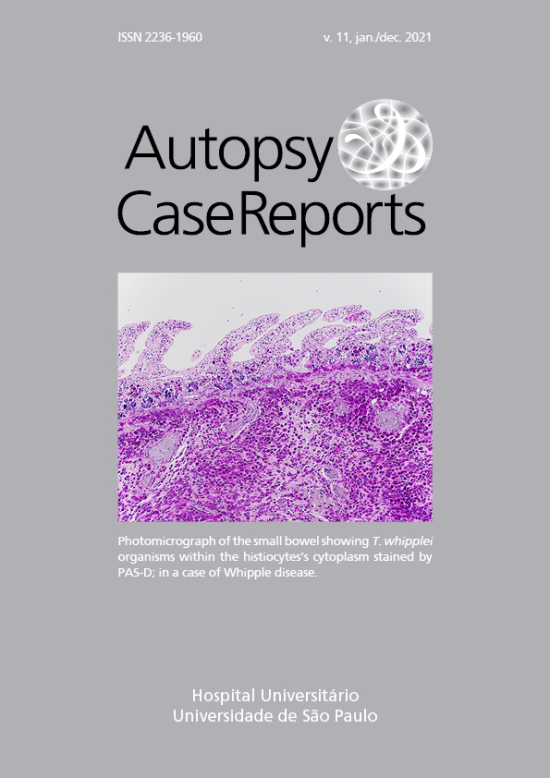Whipple’s disease: a fatal mimic
DOI:
https://doi.org/10.4322/acr.2020.237Keywords:
Autopsy, Communicable Diseases, Pathology, Polymerase Chain Reaction, TropherymaAbstract
Whipple’s Disease, a rare diagnosis caused by the slow-growing bacterium Tropheryma whipplei, most often presents with the classically described signs of malabsorption due to gastrointestinal colonization. However, it can also have signs and symptoms that clinically overlap with rheumatic diseases, potentially resulting in misdiagnosis. Furthermore, treatment with modern potent biologic immunosuppressive agents and classic disease modifying anti-rheumatic drugs (DMARDs) can lead to serious exacerbation of undiagnosed infections. We present the case of a middle-aged woman with long term complaints of arthalgias, who was diagnosed with seronegative rheumatoid arthritis and subsequently treated for almost 7 years with such immunosuppressive therapies. The patient’s disease course included chronic diarrhea that abruptly intensified and culminated in fatal hypovolemic shock/sepsis. A diagnosis of WD was made by autopsy examination, wherein several organ systems were found to be heavily involved by Tropheryma whipplei organisms, and their identification was confirmed with histochemical and molecular evaluation. Notably, most bacterial organisms were located deeply in the submucosa/muscularis of affected organs, a practical reminder to practicing pathologists that challenges the classic histopathologic description of Whipple disease as an infiltration of predominantly lamina propria, and the potential for sampling bias in typically superficial endoscopic biopsies during routine procedures.
Downloads
References
Bennett JDR, Blaser J. Mandell Douglas and Bennett’s principles and practice of infectious diseases. 9th ed. Philadelphia: Elsevier; 2019.
Fenollar F, Trani M, Davoust B, et al. Prevalence of asymptomatic Tropheryma whipplei carriage among humans and nonhuman primates. J Infect Dis. 2008;197(6):880-7. http://dx.doi.org/10.1086/528693. PMid:18419351.
Marth T, Moos V, Müller C, Biagi F, Schneider T. Tropheryma whipplei infection and Whipple’s disease. Lancet Infect Dis. 2016;16(3):e13-22. http://dx.doi.org/10.1016/S1473-3099(15)00537-X. PMid:26856775.
Schöniger-Hekele M, Petermann D, Weber B, Müller C. Tropheryma whipplei in the environment: survey of sewage plant influxes and sewage plant workers. Appl Environ Microbiol. 2007;73(6):2033-5. http://dx.doi.org/10.1128/AEM.02335-06. PMid:17277223.
Elchert JA, Mansoor E, Abou-Saleh M, Cooper GS. Epidemiology of Whipple’s disease in the USA Between 2012 and 2017: A Population-Based National Study. Dig Dis Sci. 2019;64(5):1305-11. http://dx.doi.org/10.1007/s10620-018-5393-9. PMid:30488239.
Durand DV, Lecomte C, Cathébras P, Rousset H, Godeau P. Whipple disease: clinical review of 52 cases. Medicine. 1997;76(3):170-84. http://dx.doi.org/10.1097/00005792-199705000-00003. PMid:9193452.
Lagier JC, Lepidi H, Raoult D, Fenollar F. Systemic Tropheryma whipplei: clinical presentation of 142 patients with infections diagnosed or confirmed in a reference center. Medicine. 2010;89(5):337-45. http://dx.doi.org/10.1097/MD.0b013e3181f204a8. PMid:20827111.
Puéchal X. Whipple disease and arthritis. Curr Opin Rheumatol. 2001;13(1):74-9. http://dx.doi.org/10.1097/00002281-200101000-00012. PMid:11148719.
Dolmans RA, Boel CH, Lacle MM, Kusters JG. Clinical manifestations, treatment, and diagnosis of Tropheryma whipplei Infections. Clin Microbiol Rev. 2017;30(2):529-55. http://dx.doi.org/10.1128/CMR.00033-16. PMid:28298472.
Ehrbar HU, Bauerfeind P, Dutly F, Koelz HR, Altwegg M. PCR-positive tests for Tropheryma whippelii in patients without Whipple’s disease. Lancet. 1999;353(9171):2214. http://dx.doi.org/10.1016/S0140-6736(99)01776-6. PMid:10392994.
Panegyres PK. Diagnosis and management of Whipple’s disease of the brain. Pract Neurol. 2008;8(5):311-7. http://dx.doi.org/10.1136/jnnp.2008.156836. PMid:18796586.
Fenollar F, Célard M, Lagier JC, Lepidi H, Fournier PE, Raoult D. Tropheryma whipplei endocarditis. Emerg Infect Dis. 2013;19(11):1721-30. http://dx.doi.org/10.3201/eid1911.121356. PMid:24207100.
Geissdörfer W, Moos V, Moter A, et al. High frequency of Tropheryma whipplei in culture-negative endocarditis. J Clin Microbiol. 2012;50(2):216-22. http://dx.doi.org/10.1128/JCM.05531-11. PMid:22135251.
Glaser C, Rieg S, Wiech T, et al. Whipple’s disease mimicking rheumatoid arthritis can cause misdiagnosis and treatment failure. Orphanet J Rare Dis. 2017;12(1):99. http://dx.doi.org/10.1186/s13023-017-0630-4. PMid:28545554.
Ojeda E, Cosme A, Lapaza J, Torrado J, Arruabarrena I, Alzate L. Whipple’s disease in Spain: a clinical review of 91 patients diagnosed between 1947 and 2001. Rev Esp Enferm Dig. 2010;102(2):108-23. http://dx.doi.org/10.4321/S1130-01082010000200006. PMid:20361847.
Bentley SD, Maiwald M, Murphy LD, et al. Sequencing and analysis of the genome of the Whipple’s disease bacterium Tropheryma whipplei. Lancet. 2003;361(9358):637-44. http://dx.doi.org/10.1016/S0140-6736(03)12597-4. PMid:12606174.
Raoult D, Birg ML, La Scola B, et al. Cultivation of the bacillus of Whipple’s disease. N Engl J Med. 2000;342(9):620-5. http://dx.doi.org/10.1056/NEJM200003023420903. PMid:10699161.
Rolain JM, Fenollar F, Raoult D. False positive PCR detection of Tropheryma whipplei in the saliva of healthy people. BMC Microbiol. 2007;7(1):48. http://dx.doi.org/10.1186/1471-2180-7-48. PMid:17535423.
Mahnel R, Kalt A, Ring S, Stallmach A, Strober W, Marth T. Immunosuppressive therapy in Whipple’s disease patients is associated with the appearance of gastrointestinal manifestations. Am J Gastroenterol. 2005;100(5):1167-73. http://dx.doi.org/10.1111/j.1572-0241.2005.40128.x. PMid:15842595.
Marth T. Complicated Whipple’s disease and endocarditis following tumor necrosis factor inhibitors. World J Cardiol. 2014;6(12):1278-84. http://dx.doi.org/10.4330/wjc.v6.i12.1278. PMid:25548618.
Marth T. Systematic review: whipple’s disease (Tropheryma whipplei infection) and its unmasking by tumour necrosis factor inhibitors. Aliment Pharmacol Ther. 2015;41(8):709-24. http://dx.doi.org/10.1111/apt.13140. PMid:25693648.
Maresi E, Argo A, Portelli F, Busardò FP, Raoult D, Lepidi H. Rare occurrence of Whipple Disease in a young female patient with a fatal outcome. Egyptian Journal of Forensic Sciences. 2013;3(3):85-91. http://dx.doi.org/10.1016/j.ejfs.2013.04.004.
Tandon P, Huang V, Jaffer N, Kirsch R, Croitoru K. A rare presentation of hypovolemic shock secondary to Whipple’s disease. Eur J Gastroenterol Hepatol. 2019;31(5):642-5. http://dx.doi.org/10.1097/MEG.0000000000001363. PMid:30694911.
Martinetti M, Biagi F, Badulli C, et al. The HLA alleles DRB1*13 and DQB1*06 are associated to Whipple’s disease. Gastroenterology. 2009;136(7):2289-94. http://dx.doi.org/10.1053/j.gastro.2009.01.051. PMid:19208355.
Ghigo E, Barry AO, Pretat L, et al. IL-16 promotes T. whipplei replication by inhibiting phagosome conversion and modulating macrophage activation. PLoS One. 2010;5(10):e13561. http://dx.doi.org/10.1371/journal.pone.0013561. PMid:21042409.
Moos V, Kunkel D, Marth T, et al. Reduced peripheral and mucosal Tropheryma whipplei-specific Th1 response in patients with Whipple’s disease. J Immunol. 2006;177(3):2015-22. http://dx.doi.org/10.4049/jimmunol.177.3.2015. PMid:16849516.
Schinnerling K, Moos V, Geelhaar A, et al. Regulatory T cells in patients with Whipple’s disease. J Immunol. 2011;187(8):4061-7. http://dx.doi.org/10.4049/jimmunol.1101349. PMid:21918190.
Schinnerling K, Geelhaar-Karsch A, Allers K, et al. Role of dendritic cells in the pathogenesis of Whipple’s disease. Infect Immun. 2015;83(2):482-91. http://dx.doi.org/10.1128/IAI.02463-14. PMid:25385798.
Downloads
Published
Issue
Section
License
Copyright (c) 2021 Autopsy and Case Reports

This work is licensed under a Creative Commons Attribution 4.0 International License.
Copyright
Authors of articles published by Autopsy and Case Report retain the copyright of their work without restrictions, licensing it under the Creative Commons Attribution License - CC-BY, which allows articles to be re-used and re-distributed without restriction, as long as the original work is correctly cited.



